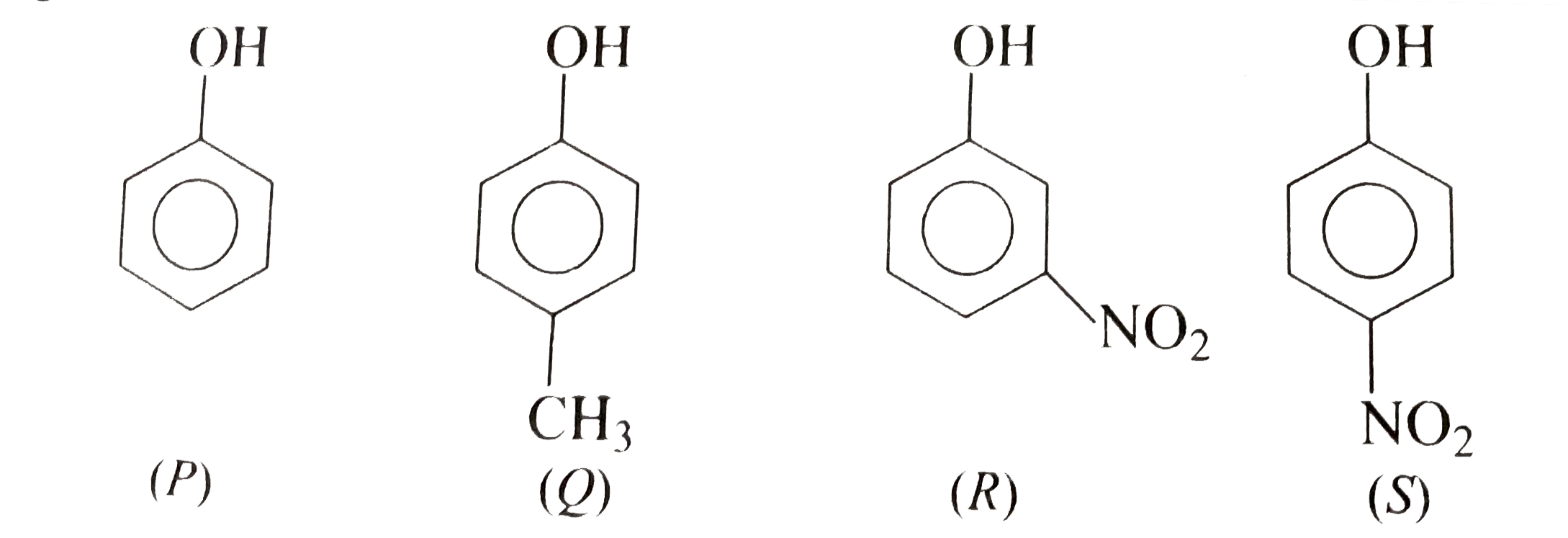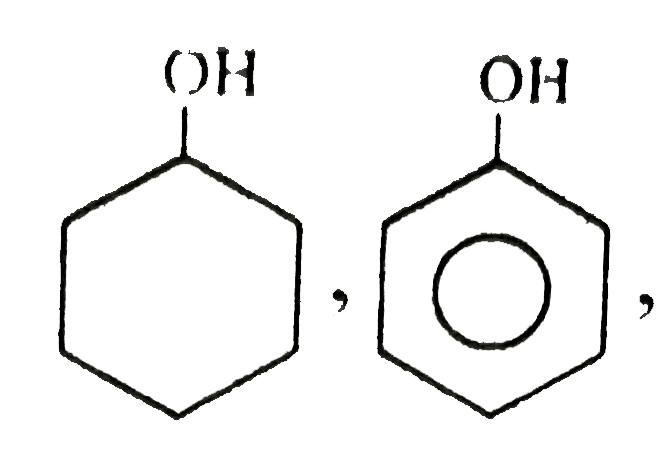Record the following sets of compounds according to increasing pKa(=−logKa)
Propanoic acid, 3-bromopropanoic acid, 2-nitropropanoic acid
The correct Answer is:3<2<1
To solve the problem of arranging propanoic acid, 3-bromopropanoic acid, and 2-nitropropanoic acid according to their increasing pKa values, we will follow these steps:
Step 1: Understand pKa and Ka
- pKa is the negative logarithm of the acid dissociation constant (Ka). A lower pKa value indicates a stronger acid, which means it dissociates more in solution to release H+ ions.
Step 2: Identify the Structures of the Compounds
- Propanoic Acid: CH3CH2COOH
- 3-Bromopropanoic Acid: CH2BrCH2COOH
- 2-Nitropropanoic Acid: CH3CH(NO2)COOH
Step 3: Analyze the Effects of Substituents
- Propanoic Acid: This compound has no substituents that affect acidity significantly.
- 3-Bromopropanoic Acid: The bromine atom is a -I (inductive effect) group, which withdraws electron density and stabilizes the conjugate base (the carboxylate ion) when the acid donates a proton. This increases acidity compared to propanoic acid.
- 2-Nitropropanoic Acid: The nitro group (-NO2) is a strong -I group and also has resonance effects. It significantly stabilizes the conjugate base, making this acid the strongest among the three.
Step 4: Determine the Order of Acidity
- Based on the analysis:
1. 2-Nitropropanoic Acid is the strongest acid due to the strong -I effect and resonance stabilization.
2. 3-Bromopropanoic Acid is next, as bromine has a weaker -I effect compared to the nitro group.
3. Propanoic Acid is the weakest acid as it has no electron-withdrawing substituents.
Step 5: Convert Acidity Order to pKa Order
- Since pKa is inversely related to acidity:
- 2-Nitropropanoic Acid has the lowest pKa (strongest acid).
- 3-Bromopropanoic Acid has a higher pKa than 2-nitropropanoic acid.
- Propanoic Acid has the highest pKa (weakest acid).
Final Order of Increasing pKa Values
- Increasing pKa Order:
2-Nitropropanoic Acid < 3-Bromopropanoic Acid < Propanoic Acid
Summary
- The final arrangement according to increasing pKa values is:
2-Nitropropanoic Acid < 3-Bromopropanoic Acid < Propanoic Acid
---
- pKa is the negative logarithm of the acid dissociation constant (Ka). A lower pKa value indicates a stronger acid, which means it dissociates more in solution to release H+ ions.
- Propanoic Acid: CH3CH2COOH
- 3-Bromopropanoic Acid: CH2BrCH2COOH
- 2-Nitropropanoic Acid: CH3CH(NO2)COOH
- Propanoic Acid: This compound has no substituents that affect acidity significantly.
- 3-Bromopropanoic Acid: The bromine atom is a -I (inductive effect) group, which withdraws electron density and stabilizes the conjugate base (the carboxylate ion) when the acid donates a proton. This increases acidity compared to propanoic acid.
- 2-Nitropropanoic Acid: The nitro group (-NO2) is a strong -I group and also has resonance effects. It significantly stabilizes the conjugate base, making this acid the strongest among the three.
- Based on the analysis:
1. 2-Nitropropanoic Acid is the strongest acid due to the strong -I effect and resonance stabilization.
2. 3-Bromopropanoic Acid is next, as bromine has a weaker -I effect compared to the nitro group.
3. Propanoic Acid is the weakest acid as it has no electron-withdrawing substituents.
- Since pKa is inversely related to acidity:
- 2-Nitropropanoic Acid has the lowest pKa (strongest acid).
- 3-Bromopropanoic Acid has a higher pKa than 2-nitropropanoic acid.
- Propanoic Acid has the highest pKa (weakest acid).
- Increasing pKa Order:
2-Nitropropanoic Acid < 3-Bromopropanoic Acid < Propanoic Acid
- The final arrangement according to increasing pKa values is:
2-Nitropropanoic Acid < 3-Bromopropanoic Acid < Propanoic Acid
Topper's Solved these Questions
- GOCBook:MOTIONChapter:GOCExercise:Exercise - 4 Level - I
Explore 13 Videos
- GOCBook:MOTIONChapter:GOCExercise:Exercise - 4 Level - II
Explore 14 Videos
- GOCBook:MOTIONChapter:GOCExercise:Exercise - 2 (Level - II)
Explore 114 Videos
- GASEOUS STATE Book:MOTIONChapter:GASEOUS STATE Exercise:EXERCISE-4( LEVEL-II)
Explore 19 Videos
- GRIGNARD REAGENTBook:MOTIONChapter:GRIGNARD REAGENTExercise:EXERCISE-2
Explore 16 Videos
Similar Questions
Knowledge Check
Rank the following compounds in increasing order of their acidity:
1. 3 - fluorobutanoic acid
2. 3 - chlorobutanoic acid
3. 2 - flurobutanoic acid
4. Butanoic acid
5. 4 - chlorobutanoic acid.A3<1<2<4<5B4<3<1<2<5C5<2<1<3<4D4<5<2<1<3Arrange the following compounds in increasing order of acidity :
 AP>Q>R>SBS>Q>R>PCS>R>P>QDR>S>R>P
AP>Q>R>SBS>Q>R>PCS>R>P>QDR>S>R>PArrange the oxides of manganese according to increasing acidic strength.
AMnO<Mn3O4<Mn2O3<MnO2<Mn2O7BMn2O7<MnO2<Mn2O3<Mn3O4<MnOCMnO2<Mn2O7<Mn3O4<Mn2O3<MnODMn3O4<Mn2O3<Mn2O7<MnO2<MnO
Record the following sets of compounds according to increasing pKa(=−logKa)
1-butyne, 1-butene, butane
View SolutionConvert propanoic acid into 2-Bromopropanoic acid.
View SolutionRecord the following sets of compounds according to increasing pKa(=−logKa)
(a). cyclohexane carboxylic acid
cyclohexane carboxylic acid
(A). 3<2<1
(B). 3>2>1
(C). 1<2<3
(D). 3<1<2
(b). 1-butyne, 1-butene, butane
(A). 3<2<1
(B). 3<2<1
(C). 1<3<2
(D). 3<2>1
(c). Propanoic acid, 3-bromopropanoic acid, 2-nitropropanoic acid
(A). 3lt2lt1
(B). 3gt2gt1
(C). 1lt2lt3
(D). 3lt1lt2
View SolutionArrange the following in order of increasing acidity:
(i) Propanoic acid, chloroethanoic acid, 3-bromo-propanoic acid and trichloroacetic acid.
(ii) 2-Fluorobutanoic acid, 2-iodobutanoic acid, 2-bromobutanoic acid and butanoic acid.
(iii) (iii) Acetic acid, 2-methyl propanoic acid, 2,2-dimethyl propanoic acid.
(iv) Oxalic acid, malonic acid, succinic acid, glutaric acid.
(v) C6H5COOH,p−OHC6H4COOH,
p−CH3C6H4COOH,p−CIC6H4COOH,
p−BrC6H4COOH,p−NO2C6H4COOH.
View SolutionArrange the following compounds in increasing order of acidic strength 2, 4-dinitrobenzoic acid, 4-methoxybenzoic acid, 4-nitrobenzoic acid.
View Solution